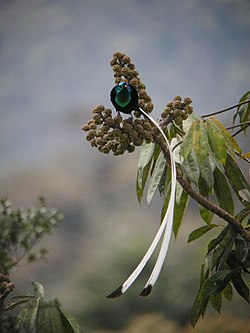| Ribbon-tailed astrapia | |
|---|---|
 | |
| Adult male A. mayeri | |
| Scientific classification | |
| Kingdom: | Animalia |
| Phylum: | Chordata |
| Class: | Aves |
| Order: | Passeriformes |
| Family: | Paradisaeidae |
| Genus: | Astrapia |
| Species: | A. mayeri |
| Binomial name | |
| Astrapia mayeri Stonor, 1939 | |
The ribbon-tailed astrapia, also known as Shaw Mayer's astrapia (Astrapia mayeri), is a species of bird-of-paradise.
Contents
The ribbon-tailed astrapia is distributed and endemic to subalpine forests in western part of the central highlands of Papua New Guinea. Like many other ornamental birds-of-paradise, the male is polygamous. The ribbon-tailed astrapia is the most recently discovered bird-of-paradise.
The ribbon-tailed astrapia is listed as Least Concern on the IUCN Red List of Threatened Species. [1] It is listed on Appendix II of CITES. The long tails of male birds add to the threat, being as though the tail makes it difficult for the species to escape from natural predators.
The scientific name commemorates the great naturalist and New Guinea explorer Fred Shaw Mayer, who was believed to have discovered the bird in 1938. However, it is now believed that explorer Jack Hides discovered the bird, while Mayer became interested in it later. [2]

